On the Use and Abuse of Cleavage
by J.R.
“[…W]hat Proust experienced in the phenomenon of remembrance as an individual, we have to experience in regard to fashion.”
–Susan Buck-Morss, The Dialectics of Seeing: Walter Benjamin and the Arcades Project, p. 39
By the end of Walter Benjamin’s life, the concept of ‘the dialectical-image’ became the focal point for his unfinished Arcades Project. The development of this concept began early in his life when he resurrected the value of allegory, distinguishing it from the symbol. Studying baroque theater in The Origin of German Tragic Drama Benjamin writes, “Allegorical personification has always concealed the fact that its function is not the personification of things, but rather to give the concrete a more imposing form by getting it up as a person” (The Origin of German Tragic Drama, p.187). Benjamin’s difficult dissertation, and the subsequently fragmented nature of his work on the transition from the baroque allegory to the modern dialectical-image, has challenged academics to make sense of his intentions. In Christine Buci-Glucksmann’s Baroque Reason, she argues that Benjamin’s dialectical-image revolved around a particular interest in modern femininity. She reads Benjamin’s fascination with strolling down the ‘spectacular’ arcades as an attempt to recuperate the flaneur sensibility of Charles Baudelaire—in whose poetry Glucksmann discovers an idealization of the lesbian and the prostitute. For Glucksmann, these antipodal figures allegorize the dialectic that interests Benjamin by “[their] potential for otherness and transgression” (Buci-Glucksmann, p. 109). The former represents the hero who defies the laws of modernity, while the latter represents the very image of modernity’s lure (Glucksmann, pp. 106-109). Benjamin himself offers a blunt interpretation of this feminine transgression: he refers to it as death. And for him, nowhere are the living manifestations of death more prevalent than in women’s fashion:
“Fashion is the medium that ‘lures sex ever deeper into the inorganic world’—the ‘realm of dead things.’ It is ‘the dialectical switching station between woman and commodity—desire and dead body.’ The woman who adorns the newest fashions is nothing more than a ‘gaily decked-out corpse’” (Buck-Morss, p. 101).
Benjamin develops this idea by arguing that death is the very condition of society, and that the natural productivity of the female threatens society as such. He echoes Freud’s remark: “Woman is the greatest enemy of civilization.” In what seems a decadent reversal, woman’s supposed threat now functions so as to disseminate society’s newest fashions. Benjamin transfers Marx’s inorganic, fetish object onto the body of the living. Baudelaire’s prostitute epitomizes modernity and capitalism as the product who literally asks to be bought. Desire is no longer directed at an organic body but at the inorganic technology that produces what Benjamin calls a wish-image. The wish-image, in its dead-stillness, resonates with a utopic longing for a primal history, that is to say,
“In the dream in which every epoch sees in images the epoch that follows, the latter appears wedded to elements of ur-history, that is, of a classless society. Its experiences, which have their storage place in the unconscious of the collective, produce, in their interpenetration with the new, the utopia that has left its trace behind in a thousand configurations of life from permanent buildings to ephemeral fashions” (Benjamin quoted in Buck –Morss, p. 114).
The wish-image, however, is not yet the dialectical-image. The difference is not within the image itself: if fashion is the site of the dialectical-image, fashion is also the site of the wish-image. Benjamin’s dialectical-image thus earns its added dimension of revolutionary potential only after the perceiver of the image recognizes its lure by inferring the entire trajectory of the image.
One of the easiest ways to get lost in the Arcades Project is to forget that Benjamin intended to consummate his ideas through the use of images. The images themselves, juxtaposed in montage, could, ideally, activate the revolutionary potential that Benjamin continually aspired towards throughout his life. Thus, in order to understand Benjamin, it would seem impossible to think through his theory without considering it through an image. Given the importance of fashion and the centrality of women’s fashion, I want to study the phenomenon of cleavage as a baroque allegorical object, as a wish-image and as a possible site of dialectics.
The dialectical-image reveals the entire history of its production. One can look at the Eiffel Tower and recognize within it the workers who laid his or her hands on it, the architect who designed it, and the politician who thought it wise to construct it. However, it is not only the history of labor that is found in an image, the history of human perception is present as well. So it goes for cleavage, it is an example of an image manifested by a historical period (feminine liberation) and, as I will argue, by an advance in visual perception achieved in baroque art. Given cleavage’s pronounced implication as a visual phenomenon, I believe that cleavage functions as a central wish-image within Benjamin’s philosophy; not only because of its proliferation and mundane insistence, but also because the constructs of its visuality evoke the very possibility of vision (as understood by Merleau-Ponty), thereby offering us a transition from the advertisement of the wish-image to the revolutionary potential of the dialectical one.
Historically, cleavage plunges deeper than its ‘predecessor’ décolletage, a form of dress where a woman reveals the skin below her neckline. At its inception in the High Middle Ages décolletage was associated with prostitutes and women of loose morals (Williams, p. 48). The mistress of King Charles VII of France, Agnes Sorel, who earned the sobriquet La Dame de Beauté, is one of the earliest women renowned for her bosom, which she displayed in décolletage fashion. A woman of means and high-intelligence, the records and her portraits all confirm that her bosom was one of the essential features attracting King Charles (D’Orliac, p. 17).
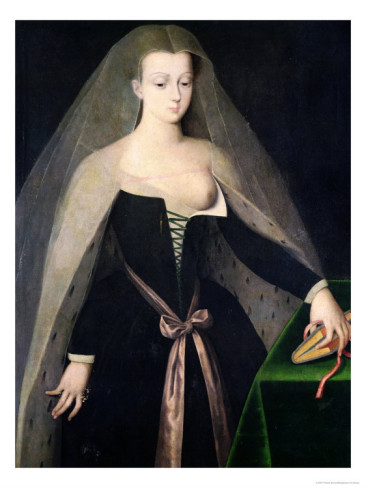
Here we see a contemporary portrait of Agnes that accentuates this famous bosom by revealing one breast and hiding another beneath a décolletage style. This is not yet cleavage. In fact the efficiency that cleavage provides is absent from this picture. We might also distinguish décolletage from cleavage by saying that a different mode of invisibility is at play. In the picture of Agnes Sorel the invisible, the other, breast lies hidden as if part of a story. Whereas with the depiction of cleavage, by hiding more, the image reveals a more immediate invisibility. What is of particular interest to me, visually, is how the baroque phenomenon of cleavage accomplishes its suggestive invisiblity by complicating the perspectival vision usually associated with Renaissance painting, in which, it is well known, the vanishing point in the center of each picture creates a seemingly 3-dimensional reality. (For example, Leonardo’s Mona Lisa exhibits what we might call proto-cleavage, a tiny slit heralding the transition from décolletage style to cleavage [Fig. 2].)
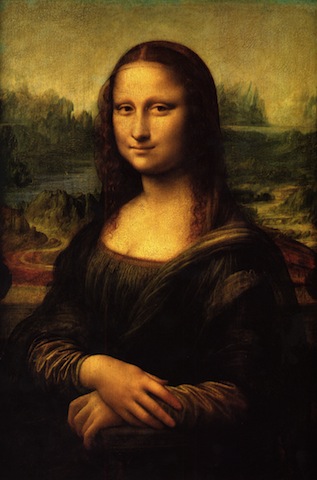
In The Rhetoric of Perspective: Realism and Illusionism in Seventeenth-Century Dutch Still-Life Painting, Hanneke Grootenboer looks at still life paintings from the Golden Age of Dutch art in order to demonstrate that the type of purity often presupposed by the invention of perspective is nothing more than a rhetorical device or an allegorical conception of sight. This latter notion returns us to Benjamin’s distinction between symbolism and allegory and directly refutes the art historian Erwin Panofsky who wrote Perspective as Symbolic Form. For Benjamin vision has a flaw, a decaying, ruin-like quality that renders the image’s form inadequate to its concept or idea. Grootenboer reiterates the allegorical (decaying) structure of vision by referring to Jacques Lacan, who tells us that there is always an absence in sight. ‘Perspective as symbolic form’ would ‘ideally’ manifest the complete equation between image and idea, whereas Lacan, staring directly at the vanishing point that makes perspective possible, sees the incompletion of vision as its very possibility. As Benjamin understands, “allegory is never saturated by meaning” (Benjamin quoted in Grootenboer, p. 136). So Grootenboer interprets the techniques of still life, baroque style par excellence, as paintings that confront and toy with the vanishing point; instead of hiding this point in the distance, still life paintings function to bring the viewer directly before it.
“The combination of a lack of depth and a lack of narrative with the extreme lifelikeness that we repeatedly see in these images raises the question whether these aspects mutually influence each other. The operation of perspective is obvious in pictorial scenes that stage a view into a landscape or an interior. It remains unclear, however, how perspective can be responsible for the lifelikness of relatively flat images such as these still lifes. The still lifes I investigate here deploy a rhetoric of perspective that enables scenes to emerge under a gaze that is not the gaze of a person. We, as viewers, do not look into a pictorial depth that offers itself to us, but rather the objects are pushed forward by their shallow space and actively confront our gaze” (Grootenboer, p. 32).
This last statement borrows its conceptual implications from Lacan’s renowned interpretation of the gaze from The Four Fundamental Concepts of Pyschoanalysis where Lacan tells a droll story about a can that gazes at a boy. Grootenboer understands the still life as a technique of perspective that confronts its own representational limitations, where the still life painter paints into the frame his or her own awareness of a picture’s ability to gaze back. The harmlessness and fantastical reality of a landscape painting, which places the vanishing point deep into the center of the frame, is frustrated by a work such as “Feigned Letter Rack Painting” by Samuel Van Hoogstraten where the image has a depth of only a couple inches (Fig. 3).
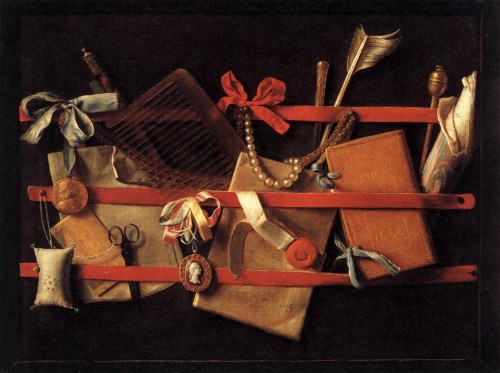
Grootenboer argues that this technique turns the vanishing point’s potential inside out, so that whereas in Renaissance landscapes the vanishing point permits a view of a scene, in baroque still lifes the vanishing point comes forward to haunt the viewer.
As such, baroque art interrogates the nature of its own representation, so much so that Grootenboer believes that this interrogation mirrors Merleau-Ponty’s phenomenology of vision (Grootenboer, p. 47), that is to say, the baroque painter touches up against the canvas with the same bracketed query we find formalized in prose or philosophy. Merleau-Ponty thus argues what still lifes suggest: that depth is essential for making any object visible, and that visibility, any visibility, presents “an intertwining of vision and touch.” This latter logic brings cleavage back within our sights, as it leads Merleau-Ponty to equate depth with flesh (Grootenboer, p. 39). “It is that the thickness of flesh between the seer and the thing is as constitutive for the thing’s visibility as for the seer’s corporeity; it is not an obstacle between them, it is their means of communication” (Merleau-Ponty quoted in Grootenboer, p. 39). To feel one’s vision is to be within a flesh that gives the presence of depth, thus the viewer, because his or her gaze places him or her inside the depth of the image, is also, aside from being gazed at, being touched by what is seen. The hyper-reality of still life is a style of painting that forces the viewer to confront this concept of vision. In contrast to the initial use of perspective, which created a breadth of distance that allowed for narrative and figure, baroque art subtracts these ideologies from the picture in order to direct our attention to the ideology of perspective itself. Now, the viewer must confront his or her own desire to see.
It is thus no surprise that one of the greatest baroque painters, Rembrandt, is one of the first painters to lushly depict a woman’s cleavage (See fig. 4).
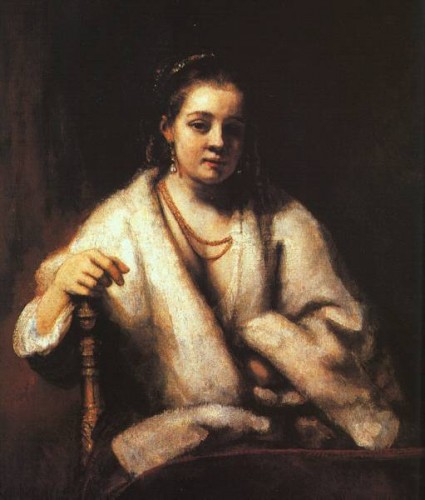
In Heinrich Wollflin’s seminal work Principles of Art History, he situates the transition between Renaissance art and baroque art within five different principles. The first principle that Wollflinn provides to differentiate the two regimes of art is the move from the linear to the painterly. He annotates this move as follows: “Painterly. Volumes and outlines merge. Edges blur, creating a shifting or moving quality” (Minor, p. 29). The painterly technique of the baroque uses light and shade as a way to emphasize the tactility of each figure. Rembrandt, a consummate baroque master for Wolflinn, famously used the process of chiaroscuro to paint rich, directed light into each of his pictures. Rembrandt used thick strokes of dark paint and bright paint to invest figures in his painting with a tactile presence. In Rembrandt’s painting of Hendrickje Stoffels (Rembrandt’s housekeeper and most likely his mistress), this thick shade of black, which executes the technique of chiaroscuro, brings startling definition to Stoffels’ cleavage. Remembering Grootenboer’s argument above, we can now gaze at this space of cleavage in the same way Grootenboer gazes at still lifes. Here, with cleavage, we have a very shallow depth that conveys the very possibility of depth itself. The wall of flesh behind cleavage, the sternum, replaces the blank walls in still life paintings. And the protruding food, which once inspired Schopenhauer to denounce still lifes for being so realistic that they stirred his appetite, is replaced by the protrusion of flesh itself.
***
Though flesh and depth sound ripe with meaning, it is hard to accept these notions blindly; in truth, to say depth is flesh is little more than a tautology. We must stop and ask: how does this depth create meaning? How does depth maintain or transmit its allegorical constitution? Gilles Deleuze helps us make some headway with these questions in his book The Fold: Leibniz and the Baroque when he writes,
“Inflection is the ideal genetic element of the variable curve or fold. Inflection is the authentic atom, the elastic point. That is what Klee extracts as the genetic element of the active, spontaneous line. For Klee…the point moves along an inflection. It is the point of inflection itself…” (Deleuze, p. 12).
Deleuze describes the visual experience of this inflected point or fold by comparing it to the ogive, or the pointed arch: “The ogive expresses the form of a moving body that espouses the configuration of lines of flowing liquid, and the return, the profile of the depth of a valley when waters are brought together following the line of a single course” (Deleuze, p. 16). Deleuze’s book includes a picture of a series of ogives that look surprisingly similarly to a series of breasts (Fig. 5).
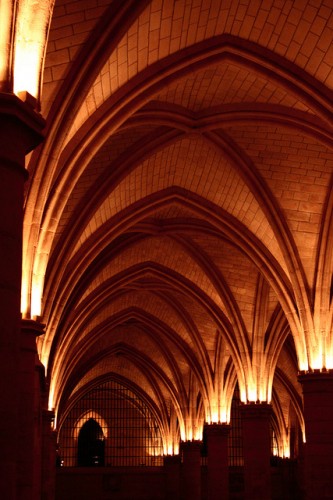
So I read the ogive as the “matheme” of cleavage, like the ogive it evokes a spontaneous line that inflects itself into an infinity of variable curvature, where a shadow, or “profile of the depth of a valley”, conveys the bending capacity of the line. Deleuze argues that the inflective or folding nature of the line creates two floors, two planes, which can be interpreted as the two effects any line has on a viewer. The first floor is the appearance, the lure, the immediate integration of the image—and it leads directly, in baroque architecture for example, to the transcendental plane of the second floor. A Church tempts the viewer into its walls, gazes down, pulls the viewer into its center, only to have the viewer look up at a dome that instills a feeling of otherness in such a way so as to carry the viewer out of the Church’s structure altogether. Cleavage, which possesses the same visual fold, mimics this process of the church.
The first psychoanalytic theorist of fashion, John Carl Flügel, tells us, “clothing is a compromise between the fear of, and the desire for, nudity” (Flugel quoted in Barthes, p. 26). Thus, instead of inflecting us towards God, cleavage inflects us towards the hidden plane of nudity. Given that cleavage is decidedly feminine, it not only conveys to the viewer an intimation of nudity but also transmits the transcendental otherness of feminine sexuality. This reveals, again, why the flesh and depth duality offered by Merleau-Ponty does not convey the whole picture. Flesh and depth lead outside of themselves towards an otherness beyond sight. We might hedge this critique, however, by noting that flesh and depth seem to be the most suggestive of that which is beyond sight, they are that which has the power to be perceived as flesh and depth. The perspective or trompe l’oeil of cleavage perfectly, in the sense of the Ancient telos, disorients its viewer.
***
A sight of absence, cleavage constantly shifts between the presentation of a vertical line and a horizontal one. In this sense cleavage depicts the very illusion of the Renaissance perspective, where, technically, the painter used vertical lines to create the horizon. The trick of depth is the truth of depth and from this depth vision overflows with flesh. Depth is thus made possible by the inflection of the line, by the shadow, and finally by its inclusion of a bracketed absence. This little black line drawn between the two ogive formations is enough to lure almost any gaze in its direction, thereby encouraging the viewer to see or desire beyond the flesh. (Look at the deep black line in one of El Greco’s many depictions of Jesus’ chest [Fig. 6]).
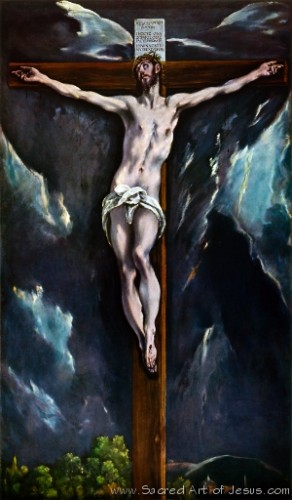
As we have already mentioned, the terminology lure and being gazed at originate from Merleau-Ponty’s friend Jaques Lacan, the foremost thinker of feminine alterity. If Merleau-Ponty introduces an immanent phenomenology of vision, and Deleuze introduces the manner in which vision pulls us beyond what we see, Lacan invests vision with the Freudian theory of libido. For Lacan, the vanishing point is the absence that makes vision possible just as the castrated phallus is the lack that makes sexuality possible. Lacan conflates these two ideas in his small section ‘On the Baroque’ in Seminar XX: On Feminine Sexuality. There he claims that Christianity has always been baroque, or that it consummated its vision in the baroque because it was always obsessed with the body, well… Christ’s body, which is essential for disseminating the tenets of Christianity: it is through Christ’s body that the faithful achieve absolution. For Lacan, the importance of the body culminates in the obscenity of the baroque. “… ‘baroquism’ with which I accept to be clothed—everything is exhibition of the body evoking jouissance.” (Lacan, p. 113) Lacan adds that there is no copulation taking place in the ‘orgy’ of churches in Italy. That is to say that these obscenities of the body refrain from consummation, they always remain incomplete, they never satisfy. Cleavage is constituted identically. There is no touching cleavage despite its visual capacity to evoke tactility. Cleavage also disappears in the act of consummation.
Though it would seem impossible to make a definitive statement about the allure of cleavage, it is indisputable that cleavage is situated within the modern psyche of sexuality and vision. If it is true that, “the other appears to hold the ‘truth of the subject and the power to make good its loss,” then cleavage exists halfway between the other and the viewer (the desirer). “In fashion, the phantasmagoria of commodities presses closest to the skin… Now clothing is quite literally at the borderline between subject and object, the individual and the cosmos” (Buck-Morss, p. 97). A close up of cleavage includes the flesh of the partially exposed breast and the brassiere or blouse that produces this ‘special’ effect. Like the staging of ghosts via light projections in baroque theater, with cleavage the technology that produces the effect is exposed, it becomes part of the excitement and titillation of the effect: as if the presentation of what fabricates desire makes the image even more desirous. The temptation of cleavage excites the viewer by blatantly exposing its trick. At last, in the deceptive bluntness of modern fashion and modern special effects, man no longer conjectures about what is behind the curtain. It is the mere fact that there is a curtain which excites modern man.
This distinction is important to Benjamin, who theorizes a metaphysical transition from the baroque allegory to the modern one. Baroque allegory, like the example above with the church, through its ruin or fragmentation (inflection), compels our gaze towards a second floor that evokes the absolution of God. Modern allegory, however, evokes a nihilistic spirituality. “Between law and justice, the theological metaphor embodies a critical-utopian distance, a different idea of politics which Benjamin, influenced by Nietzsche, calls ‘nihilist’” (Buci-Glucksmann, p. 66). This transition implies a complex dialectic between progression and stagnation. On the one hand, the proliferation of fashion democratizes allegory. It is no longer disseminated by some all-powerful king in order to captivate his citizens. Once the fashion of cleavage is accessible to all classes, every woman can now display the virtues of feminine liberation. On the other hand, “‘Fashion prescribed the ritual by which the fetish commodity wished to be worshipped’” (Benjamin quoted in Buck-Morss, p. 98). Such Liberation does not preclude the capacity for allegory, it merely transvaluated baroque metaphysics into nihilistic ritualism. It is here that the difference between the wish-image and the dialectical-image surfaces again.
As a wish-image, cleavage represents a ritual site of worship in Benjamin’s unique logic of commodity fetishism. “‘The souvenir is the relic secularized’… Thus allegory finally discovers all its depths of forgetting and being forgotten, its true destructive principle, its ‘most precious booty’: woman” (Buci-Glucksmann, pp. 77-78). If the dialectical potential of cleavage remains buried within it, then, cleavage, as a wish-image, reinforces the tenets of the ‘new religion’ that is commodity fetishism. However, if the souvenir of the forgotten is brought to the attention of thought, the construct of the allegory potentializes a revolutionary dialectic. (See opening quote about Proust above). This is Benjamin’s ultimate hope, and it is one that, to this day, remains incomplete. If a theoretical discussion of a wish-image, such as the one taken up in this essay, treats cleavage dialectically, as an image that informs the viewer both of its presence and of the forgotten history that actualizes its shocking value, it seems unlikely that such articulations have much impact on the general order of things. Since the advent of the Internet, cleavage has been distributed exorbitantly. It is secretly and blatantly (the dual logic of all special effects) used to advertise innumerable commodities, not to mention its proliferation on profile pages such as Facebook, where it advertises an individual (her)self.
Jacqueline Rose argues, reading Lacan, that the woman must look perfect to prevent the man from encountering his lack. Perfection demands stasis, it demands inorganicity. This echoes the frozen dialectic essential to Benjamin. We all know that breasts move, yet within modern brassieres, the cleavage line remains stagnant. This aligns the female body with the commodity, in that both project a freshness and imperturbability that defies the decaying nature of life. Baroque architecture is colloquially renowned for adding movement to the façade of a building; however, it is only by the juxtaposition against the stillness of deep, shaded lines that this movement appears. The flesh accentuated by the fading line of cleavage moves towards the viewer. By invading, projecting forth as a gazing at that lures subjects in, cleavage incites a secular spirituality. Vision itself becomes the rhetorical device through which the allegory of otherness protrudes; its folds pull us into a depth that compels a nearness to flesh that is never consummated.
In this sense, cleavage, today, is a mere object of desire that the woman dresses herself in. If cleavage is the signifier, its signified is sexual otherness. Like slacks or skirts, ‘she with the anatomical possession of breasts’ is able to dress herself in cleavage. Once cleavage is arbitrarily agreed upon as a site of sexuality, the complexity of its visual impact, and the excluded history of its production, no longer have any relevance. Cleavage, like other marks of sexual difference, influence the production of clichés such as: ‘men love cleavage’ or ‘women are essentially constituted to lure men to their bedside’. The technological developments of cleavage since the High Middle Ages are forgotten in the visual pleasure of cleavage.
However, because of the artificial qualities of cleavage’s allure, the logic of the dialectical-image asserts itself, striking a chord with feminist theory. That is not to say that cleavage should be banned. Any prescription prohibiting cleavage would only highlight the sexual difference cleavage produces. Treating cleavage as one of Benjamin’s dialectical-images allows us to perceive cleavage’s legacy, its souvenir. Benjamin believed that writing could only activate the potential of revolution by maintaining a constant political register. By accomplishing this, the wish-image, the site of secular ritual, renounces its essentialism, entering the realm of speculative thought. The presumption that cleavage possesses a ‘genetic’ allure is proven false by the historical development of its possibility. In this sense both men and women are united again in the democracy of thought. On the other hand, abiding within the logic of the wish-image reasserts the lame duality of gender where man seeks to consume cleavage and woman seeks to provoke this consumption.
If baroque allegory was staged in Churches, in paintings, and in theater, modern allegory is found in the mundane. “‘We penetrate the mystery only to the degree that we recognize it in the everyday world, by virtue of a dialectical optic that perceives the everyday as impenetrable, the impenetrable as everyday’” (Benjamin quoted in Buci-Glucksmann, p. 45). It is this acceptance of unfufillment that ruptures the insistent reproduction of the fetish object. “‘What is involved here is that the expectation roused by the look of the human eye is not fulfilled. Baudelaire describes eyes of which one is inclined to say that they have lost their ability to look’” (Benjamin quoted in Buci-Glucksmann, p. 75). Cleavage’s ‘primal past’ suggests the impossibility of vision, the impossibility of a consummate sight. Every subject is confronted with the chance to remove him or herself from the implication of desire’s alteration of self by seeing in plain vision the simultaneous lure and lack of sight.
BIBLIOGRAPHY
Barthes, Roland. The Language of Fashion, ed. Andy Stafford and Michael Carter, trans. Andy Stafford (Oxford: Berg, 2004).
Benjamin, Walter. The Arcades Project, trans. Howard Eiland and Kevin McLaughlin (London: The Belknap Press of Harvard University Press, 2002).
Benjamin, Walter. The Origin of German Tragic Drama, trans. John Osborne (London: Lowe & Brydone Printers Ltd., 1977).
Buck-Morss, Susan. The Dialectics of Seeing: Walter Benjamin and the Arcades Project. (London: The MIT Press, 1989).
Deleuze, Gilles. The Fold: Leibniz and the Baroque, trans. Tom Conley (Minneapolis: University of Minnesota Press, 2007).
D’Orliac, Jehanne. The Lady of Beauty, trans. M.C. Darnton (London: J.B. Lippincott Company, 1931).
Grootenboer, Hanneke. The Rhetoric of Perspective (London: The University of Chicago Press, 2005).
Lacan, Jacques. Seminar XX: On Feminine Sexuality, The Limits of Knowledge, 1972-1973, ed. Jacques-Alain Miller, trans. Bruce Fink (London: W.W. Norton & Company, 1998).
Minor, Vernon Hyde. Baroque & Rococo. (London: King, 1999).
Rose, Jacqueline. Sexuality in the Field of Vision. (London: Verso, 1988).
Williams, Julia Lloyd. Rembrandt’s Women (Edinburgh: National Gallery of Scotland, 2001).
Appendix or an Example of Italian Baroque Cleavage:
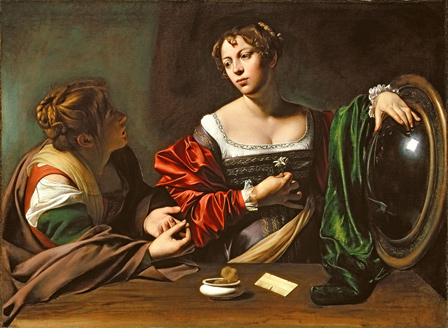
http://www.wikipaintings.org/en/francisco-de-zurbaran/saint-lucy-1630#supersized-artistPaintings-198654
While these Baroque depictions evidence a rupture within the site of cleavage as a “wish-image”, it might simultaneously be fruitful to deploy this site as an historic bridge to the past. Bridges are bi-direcitonal, after all. In particular, how would J.R. regard the infamous 4th Century (AD) “Sala delle Dieci Ragazze” mosaics (aka “Bikini Girls”) found in the Villa Romana del Casale in Sicily? Might this offer an earlier example of proto-cleavage than Leonardo’s “Mona Lisa”, and what of the notion that frontal cleavage could represent a sublimated reversal and/or projection of the posterior (aka buttocks) upon frontal iconography?
http://en.wikipedia.org/wiki/File:Casale_Bikini.jpg
http://en.wikipedia.org/wiki/File:Villa_Romana_del_Casale_Schlafzimmer_Mitte_modified.jpg
@Peaty, indeed with the buttocks. However, though I imagine lineage can easily be fanned out beyond my frame (mainly Renaissance to Baroque), I would decline the “Bikini Girls”. They seem to lack the depth, I mean by they ‘their breasts’, that I am looking for, and as such, the ever-suggestive vertical shade of black. I wonder what it says though that that shading is very evident in the buttocks far before it is in the breasts. Perhaps sublimation as you suggest, or at least transvaluation, both of which are interesting to think about in relation to fashion.